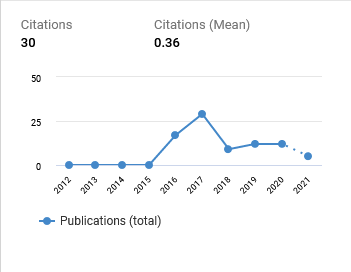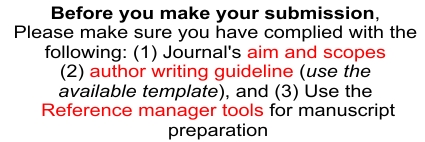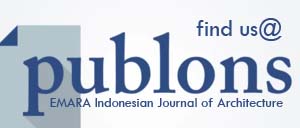Phenomenological Study of Toba Batak House Tectonic
DOI:
https://doi.org/10.29080/eija.v7i2.1130Keywords:
phenomenology,, tectonics,, archipelago architecture,, craftsmanshipAbstract
Indonesia is a super cultural power country, rich in customs and culture line from Sabang to Merauke, from Nias to Rote Island. Cultural wealth breeds architectural diversity. The potential of original Indonesian architecture has begun to be left behind and eroded by foreign cultures. The postmodern era has raised Nusantara Architecture to the world stage. Researches on the wealth of Nusantara architecture begin to bloom like mushrooms in the rainy season. The phenomenon of the skills or expertise of the masters has made traditional houses an endless research material. The purpose of this research is to explore the treasures of the Indonesian nation's wealth, especially the craftsmanship skills of Indonesian ancestors. The phenomenon of tying, knitting, and stringing materials into architectural masterpieces is a uniqueness and uniqueness that other nations do not have. The method used in this study uses the phenomenological method. Where in the vernacular architectural phenomenology is divided into two branches; first: related to space, place, and atmosphere, second: related to tectonic or the art of construction more on the elements of craftsmanship. The results of this study reveal that simple and straightforward technology becomes effective when it comes to craftsmen who have special skills. The conclusions of this study indicate that the skill of the masons is more dominant than the tools used, on the other hand, currently tools are more dominant than the skills of the masons.
Downloads
References
Frampton, K. (1995). Studies in Tectonic Culture: The Poetics of Construction in Nineteenth and Twentieth Century Architecture (J. Cava, Ed.). MIT Press.
Gazette, R. (2017). The etymology of architecture –. Ripon Civic Society . https://riponcivicsociety.org.uk/2017/10/05/the-etymology-of-architecture/
Griffero, T. (2016). Atmospheres: Aesthetics of Emotional Spaces . Routledge. DOI: https://doi.org/10.4324/9781315568287
MacManus, SC (2014). Architectural Tectonics: A Shift Between the Cultural Tradition of Making to Contemporary Building Processes [Master Thesis, Virginia Tech]. https://vtechworks.lib.vt.edu/handle/10919/25235
Mangunwijaya, YB (2009). Wastu image: An introduction to the cultural science of architectural forms, the foundations of its philosophy, along with practical examples . PT Gramedia Pustaka Utama.
Maulden, R. (1986). Tectonics in architecture: From the physical to the meta-physical [Thesis, Massachusetts Institute of Technology]. https://dspace.mit.edu/handle/1721.1/78804
Napitupulu, SP (1997). Traditional Architecture of North Sumatra . Directorate General of Education and Culture.
Prijotomo, J. (2018). Prijotomo fixes the architecture of the archipelago . Wastu Lanas Graphics.
Roosandriantini, J. (2020). Use and image as a form of creativity in the architecture of the archipelago: A case study of the architecture of Tongkonan Toraja, Mamasa and Batak Toba. EMARA: Indonesian Journal of Architecture , 6 (1), 42–51. https://doi.org/10.29080/eija.v6i1.898 DOI: https://doi.org/10.29080/eija.v6i1.898
Roosandriantini, J., & Sihombing, DJC (2019). The crisis of character recognition of the physical form of Batak Toba, Batak Karo, and Batak Simalungun architecture in the younger generation. Journal of Malige Architecture , 1 (2), 1–10.
Salain, PR (2021). Blessings and Challenges of Archipelago Architecture in the Modern Era . https://simdos.unud.ac.id/uploads/file_penelitian_dir/e9d0bd755fcf7c8bf82f3da3e2ea43c5.pdf
Siahaan, U. (2019). Toba Batak Traditional House and Ornaments in Jangga Dolok Village, Toba–Samosir Regency. Journal of SCALE , 6 (2), 24–24. https://doi.org/10.33541/scale.v6i2.45
Simamora, T. (1997). Toba Batak House: Inculturative Business . Pematangsiantar.

Downloads
Additional Files
Published
How to Cite
Issue
Section
Categories
License
Copyright (c) 2021 Widriyakara Setiadi, LMF Purwanto, Antonius Ardiyanto, Rudiyanto Soesilo, B.Tyas Susanti

This work is licensed under a Creative Commons Attribution-ShareAlike 4.0 International License.
- Authors retain copyright and grant the journal right of first publication with the work simultaneously licensed under a Creative Commons Attribution ShareAlike License that allows others to share the work with an acknowledgment of the work's authorship and initial publication in this journal.
- Authors are able to enter into separate, additional contractual arrangements for the non-exclusive distribution of the journal's published version of the work (e.g., post it to an institutional repository or publish it in a book), with an acknowledgment of its initial publication in this journal.
- Authors are permitted and encouraged to post their work online (e.g., in institutional repositories, pre-print sites, or on their website) prior to and during the submission process, as it can lead to productive exchanges, as well as earlier and greater dissemination of published work.
































